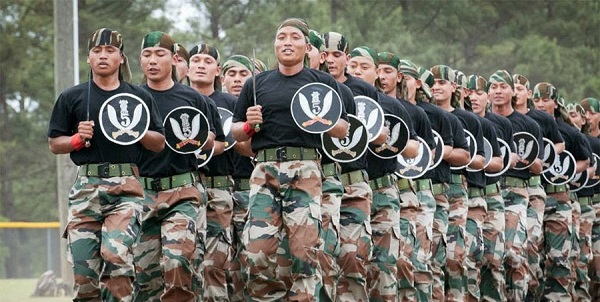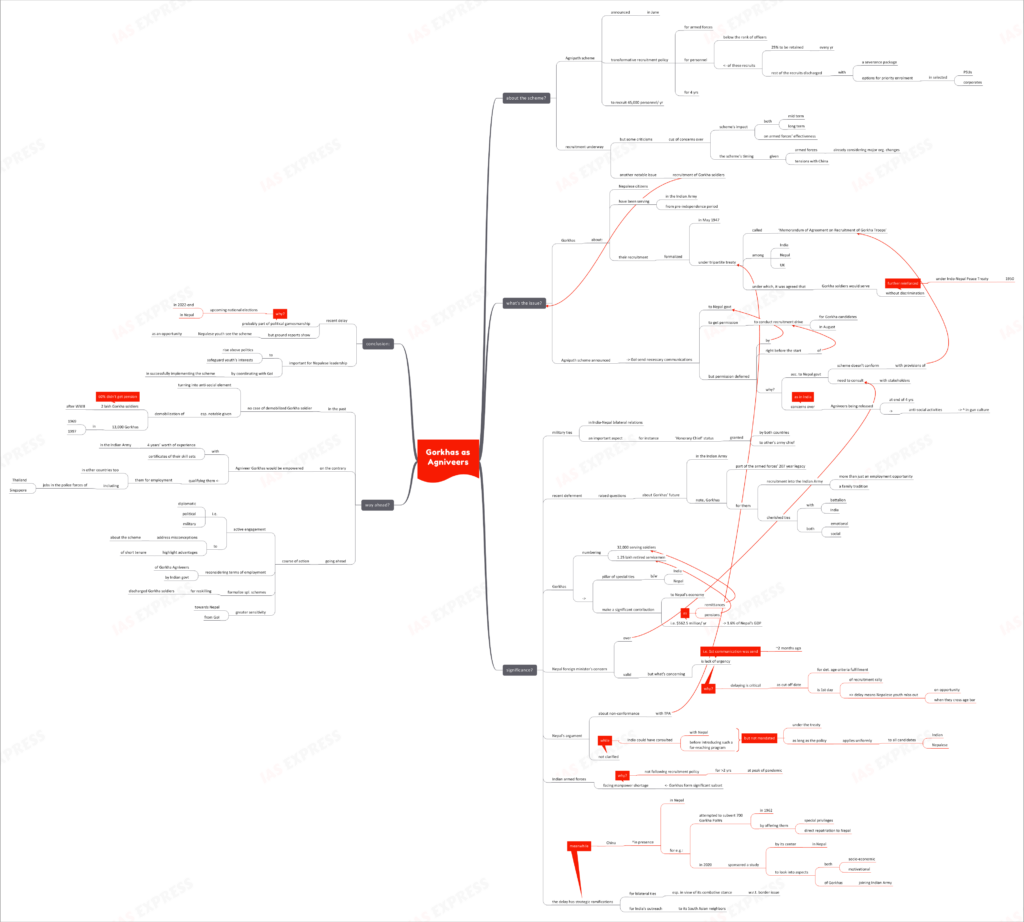Gorkhas as Agniveers

This topic of “Gorkhas as Agniveers” is important from the perspective of the UPSC IAS Examination, which falls under General Studies Portion.
What is the Agnipath scheme?
- The Agnipath scheme is a transformative recruitment policy announced in June.
- It is an armed forces recruitment program for personnel below the rank of officers for a period of 4 years.
- After this period, 25% of the recruits are to be retained every year. Rest of the recruits are to be discharged with a severance package and options for priority enrolment in selected PSUs and corporates.
- The program envisions the recruitment of 45,000 personnel per year.
- The recruitment process under this program is already underway. However, the program has been facing criticisms– stemming from concerns over the scheme’s mid- and long- term impact on the armed forces’ effectiveness and the scheme’s timing, given the armed forces are already considering major organizational changes amidst tensions with China.
- Another notable issue in focus is the recruitment of Gorkha soldiers from Nepal under this scheme.

What is the Gorkha recruitment issue?
- Gorkhas are Nepalese citizens who have been serving in the Indian Army, from before Independence. In May 1947, recruitment from Nepal was formalized under a tripartite treaty, ‘Memorandum of Agreement on Recruitment of Gorkha Troops’, among India, Nepal and the UK.
- Even in this treaty, it was agreed that the Gorkha soldiers would serve without discrimination. This was further reinforced under the Indo-Nepal Peace Treaty of 1950 that empowered Nepal nationals to work in India without discrimination.
- Following the announcement of the Agnipath scheme, the Indian government sent necessary communications to the Nepalese government, requesting permission to conduct recruitment drive for Gorkha candidates in August.
- However, before the recruitment process could start, Nepal asked India to defer the recruitment of Gorkhas under the scheme. Nepal held that the scheme doesn’t conform to the tripartite agreement’s provisions and desired to hold consultations with the stakeholders before taking a final call.
- Like in India, concerns are being raised in Nepal about Agniveers being released at the end of the 4 years, only to fall prey to anti-social activities, leading to a rise of gun culture.
Why is this significant?
- Military ties is an important foundation for the India-Nepal relations. For instance, the practice of granting the ‘Honorary Chief’ status by the countries to the other’s army chief is still continued.
- The recent deferment has raised questions about Gorkhas’ future in the Indian Army. They have been part of the armed forces’ 207 year legacy and for many Gorkha families, recruitment into the Indian Army is more than just an employment opportunity. It is a family tradition and they cherish social and emotional connection with the battalion and India.
- The 32,000 serving soldiers and the 1.25 lakh retired servicemen of the community form a pillar of special ties between the two neighbouring countries.
- Also, they make a significant contribution to the Nepalese economy. Some $562.5 million is annually added to the Nepalese economy and this accounts for 1.6% of the country’s GDP.
- While the Nepalese Foreign Minister’s concern for the need for wide consultation is understandable, the lack of urgency in the matter is concerning. The Indian Embassy sent the 1st communication about the recruitment nearly 2 months ago.
- The delay is critical as the ‘cut off’ date for determining whether or not a candidate fulfils the age criteria is the recruitment rally’s 1st day. By delaying permission, the Nepal government has inadvertently put a large section of its youth, who would have crossed the age bar, at a disadvantage.
- While Nepal has argued that the scheme doesn’t conform to the TPA, it hasn’t clarified which specific provision of the agreement is being allegedly violated. While many opine that India should have consulted Nepal before introducing such a far-reaching program, given the bilateral ties, the TPA doesn’t mandate such a consultation as long as the policy applies uniformly to Indian and Nepalese candidates.
- Indian armed forces are facing an alarming deficiency in manpower, as a consequence of not following a recruitment policy for over 2 years in the peak of the pandemic. And Gorkha soldiers constitute a significant subset of the manpower.
- Nepal delaying its permission has strategic ramifications for its ties with India, especially in view of its combative stance on the border issue and also for India’s outreach to its South Asian neighbors.
- Meanwhile, China is increasing its presence in Nepal and has been using every opportunity to drive a wedge between Nepal and India. In 1962, China attempted to subvert 700 Gorkha prisoners of war by offering them special privileges and direct repatriation to Nepal. In 2020, when the India-Nepal ties were at a low, China sponsored a study by one of its centers in Nepal to look at socio-economic and motivational aspects of Gorkhas joining the Indian Army.
What is the way ahead?
- Looking at the past, there haven’t been a case of demobilized Gorkhas turning into anti-social elements. Notably, some 2 lakh Gorkha soldiers were demobilized after the World War II (60% didn’t get pensions) and the further demobilized 13,000 Gorkhas in 1969 and 1997 as part of its downsizing drive.
- On the contrary, the Agniveer Gorkhas would be empowered with the 4 years’ worth of experience in the Indian Army and certificates of their skill sets. This would qualify them for employment in other countries too, including jobs in the police forces of Thailand and Singapore.
- Going ahead, the following course of action can be adopted:
- Active engagements– diplomatic, political and military- at different levels to address misconceptions about the scheme and highlight the advantages of short tenure
- Reconsideration of the terms of employment of Gorkha Agniveers by the Indian government
- Formalization of specially designed reskilling programs for discharged Gorkha soldiers
- Greater sensitivity from the Indian government to Nepal
Conclusion:
- It is probable the recent delays are part of political gamesmanship, given the upcoming Nepal national elections by 2022-end. However, ground reports show that the Nepalese youth look upon this scheme as an opportunity to pursue their dreams.
- It is important that the Nepalese political leadership rise above politics and safeguard the interest of its youth by coordinating with the Indian government for the successful implementation of the Agnipath scheme.
Practice Question for Mains:
Examine the role of Gorkha soldiers in the Indian Army in the India-Nepal ties. What is the role of Agnipath scheme in this equation? (250 words)
Referred Sources

